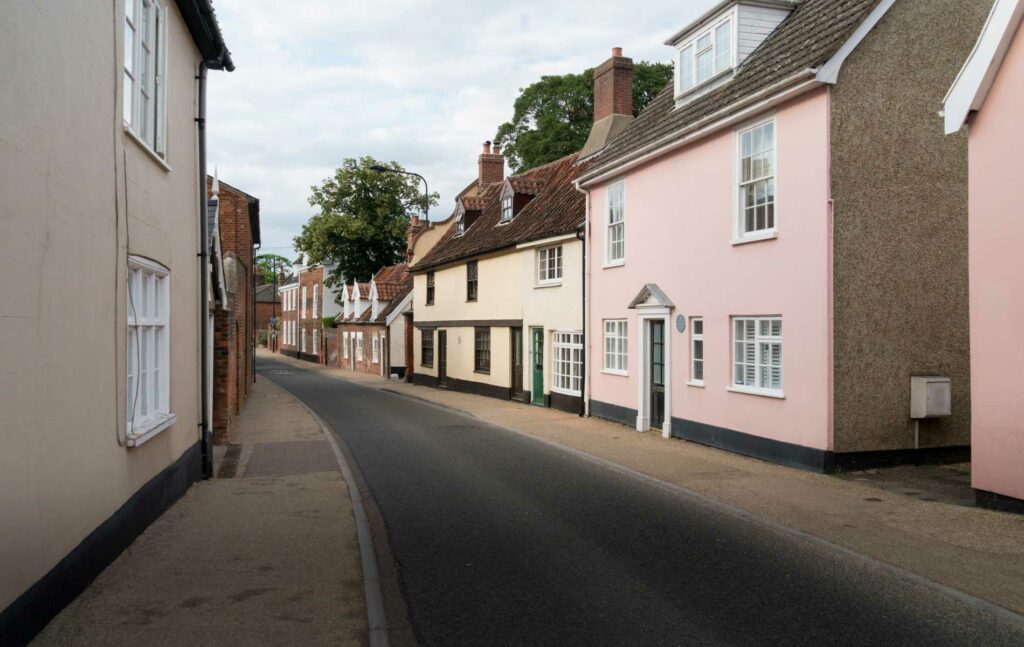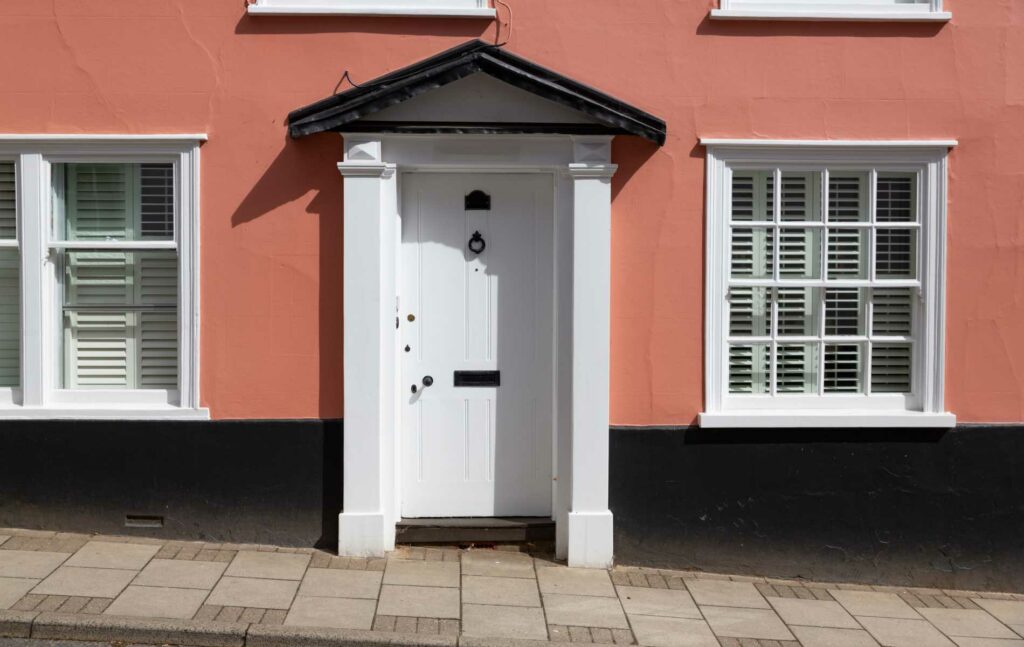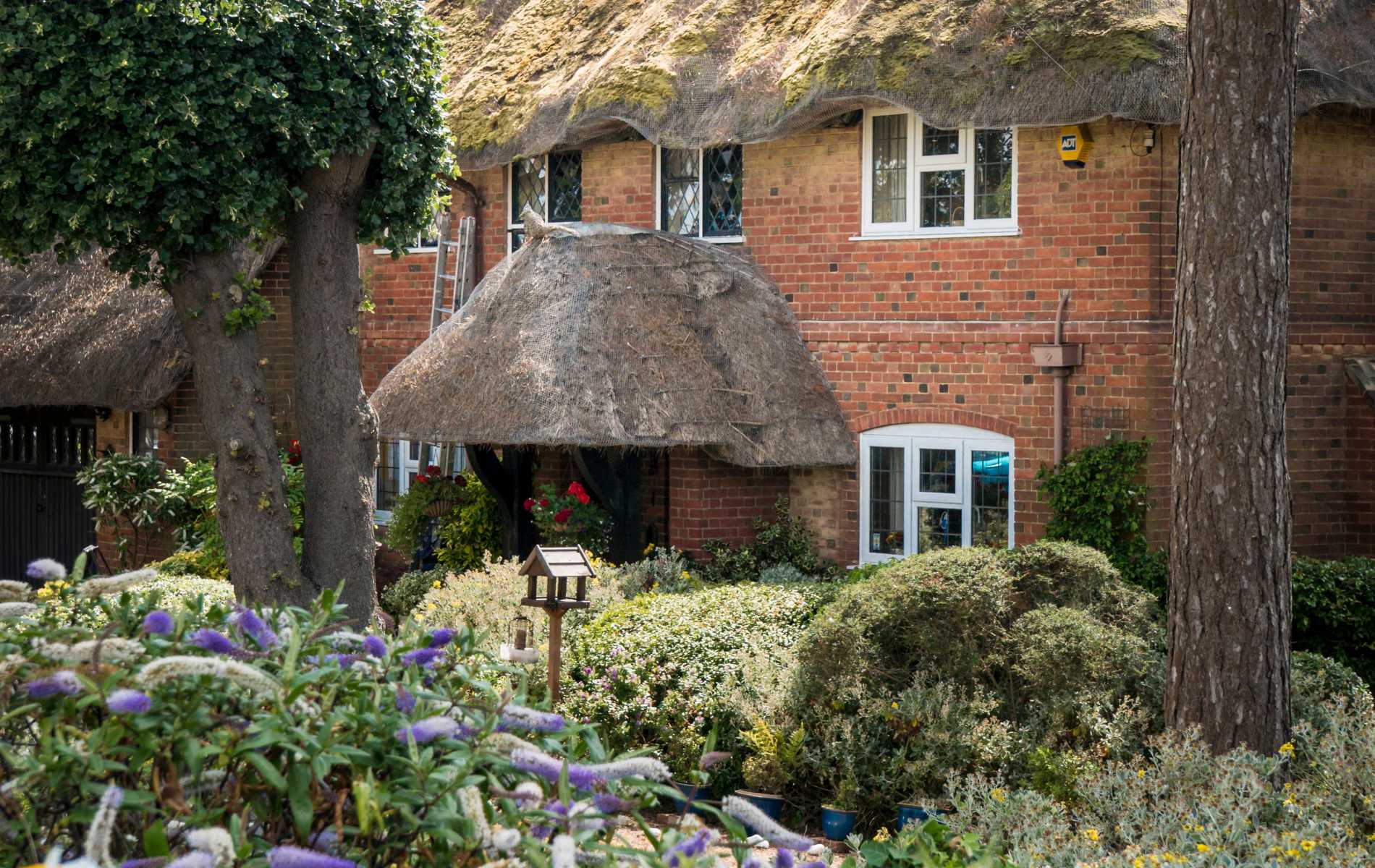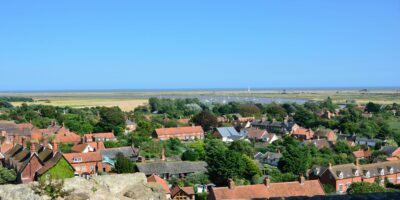
Suffolk architecture: What types of homes are for sale?
A lovely combination of character, half-timber Tudor framed dwellings, grey flint, thatched roofs, chimney stacks and pargetting – Suffolk architecture is nothing if not varied.
And on that note, it’s also colourful. The area is, in fact, very well-known for its ‘pink’ houses. This rather strange anomaly is due to local fabric dyers who resided in the area several hundred years ago.
They turned their colouring talents to lime whitewash – for which they created shell-pink, rose-pink, geranium and raspberry shades.
This was achieved by adding elderberries, crumbled red earth and even dried blood to the lime whitewash, which, when well mixed, would be spread onto the exterior of the houses being built in local villages.
Later, equally bright shades of ochre and terracotta were added to the colour palette for East Anglian homes.

Flint houses as ‘a necessity’
Before the 18th century, the architecture in Suffolk was dictated – like many other locations throughout the UK – by what local materials were available.
As a county without quarries or brickworks, East Anglian homes were created using a jumble of flints from the beaches and marshland rushes, together with clay and timber from local farms.
The width of a timber-framed house depended on the length of the spar, resulting in narrow homes.

Pitched roofs were built steep to ensure the thatch and stacks weren’t a fire risk. The roofs projected far out over rendered walls to protect the house from the rain.
Some houses had oversailing upper storeys and others diamond-paned windows. Many had pargetting – that decorative curlicues render so evocative of its time.
The village of Long Melford is an excellent example of rows of higgledy-piggledy vernacular houses.
Some are plastered, others are timbered, and those with impossibly tall Tudor chimney stacks. The village of Lavenham contains almost 350 mediaeval-listed buildings.
The rise of the Victorian tenement
In the 18th century, many of the older homes were refronted with Georgian architecture.
The 19th century was a time of urbanisation, and terraced Victorian properties were built to accommodate people flocking to look for work in the new industrial centres.
Locally-produced brick and slate roofs were the architectural sign of the times.

Contemporary architecture in Suffolk
These days you can take your pick of beautiful contemporary homes in Suffolk to admire – for the area is certainly not short of wonderful dwellings (or architects, for that matter).
Norman Foster designed the spectacular Sainsbury Centre for Visual Arts at the University of East Anglia in Norwich. He can also lay claim to the three-storey, glass-walled Willis Faber & Dumas Insurance Headquarters in Ipswich.
Built between 1970 and 1975, it certainly doesn’t look out of place with many of today’s designs.
The following are some rather special architectural designs – all of which can be found in Suffolk today:
Wood Farm
Set in an Area of Outstanding Natural Beauty (AONB), Wood Farm is a mixture of original farm buildings and sustainable, contemporary design.
Former barns with glass walls have been built using local materials. New oak-clad rooms are joined to an old galvanised zinc barn.
The house has been constructed using reclaimed handmade Suffolk bricks, terracotta tiles, and galvanised steel. Flint and green oak are mixed with modern laminated timber, oversized frameless glass and black zinc. Porcelain cladding provides a luxurious finishing touch.
Thorpeness Beach House
This seaside holiday home retreat is two storeys high and built to accommodate three generations of the same family.
The six-bedroom property sits between a beach and woodland.
Glazing panels at the front and back slide open to add more space, with the living and dining areas in the centre of the house. A large first-floor balcony provides stunning views.
Pale-toned bricks make up the exterior façade, while oak frames the windows and clads the first floor.
There are large-format floor tiles, an olive-green-hued kitchen and a wooden staircase. Gabion walls filled with rocks were installed to provide screening and boundary marking.
Dune House
Also in Thorpeness, and near the beach, the two-storey Dune House has a Mansard roof upper-storey exterior sitting on an entirely glass-walled lower floor.
Concrete and aluminium make up the rest of the materials used on the ground floor. The upper storey is clad in dark stained wood, deliberately mimicking the gabled barn-like buildings in the area. The contrasting metallic panels on the roof enclose four triangular bedrooms and a library.
Grass-covered dunes keep strong sea winds away from the ground floor of this building, which is actually a holiday home for rental.
Sliding doors on the bottom of the building give the upper storey a ‘floating’ look.
West Stow Lodge
At West Stow Lodge, a traditional exterior with a pitched roof is mixed with a pared-back interior comprising plenty of oak joinery, white-painted bricks, and polished concrete flooring.
It’s home to a family with three young children near Bury St Edmunds in the Tudor village of Lavenham.
The exterior of the white render and red bricks mirrors the local architectural style, while there are contemporary features such as an open-plan kitchen, dining and living space at the back.
The three-storey home has a row of glass doors along the corridor next to the stairs, opening up to a courtyard at the rear.
This allows natural ventilation and a flow for guests from the front door to the garden.
Balancing Barn
Possibly one of Suffolk’s most celebrated architectural holiday home rentals, the Balancing Barn is so-called because half of it is suspended (cantilevered over the countryside).
The idea of a team led by philosopher Alain de Botton, the 30-metre-long property sits near the towns of Walberswick and Aldeburgh.
It’s clad in silver reflective steel tiles and has huge panoramic windows from which to view ponds, meadows and woodland.
It features four double bedrooms with en-suite facilities, a wood burner, and an open-plan kitchen and dining area.
A swing hangs from underneath the house. And why not?
Suffolk architecture

Garrington is one of the most respected, well-known brands in the property-finding industry.
Our logical approach to home search and enviable reputation acting as trusted advisors to an array of successful clients, together with our expertise and market intelligence, ensures we succeed in finding even the most obscure properties throughout the UK.
To find out how we can help you find your next home, contact us today. Download our UK property market review to get the latest updates in the property industry.



